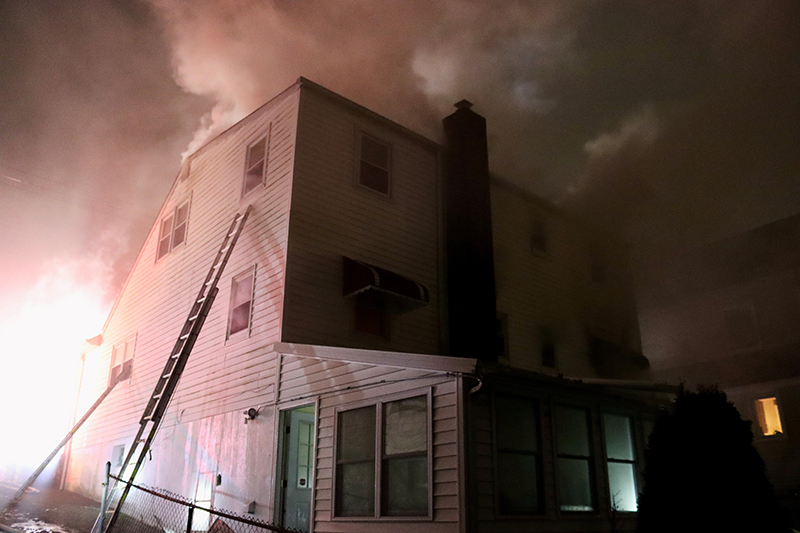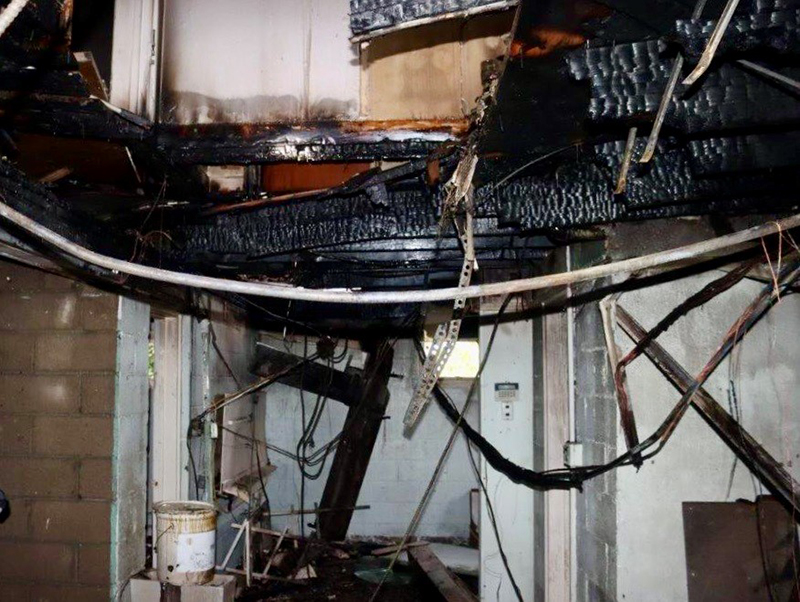BY PAUL VNUCZENSKI
At 2251 hours on December 10, 2022, a 911 call was received reporting that there was “a lot of smoke” coming from the caller’s neighbor’s house. The Yonkers (NY) Fire Department immediately dispatched a full structure fire assignment (four engines, two trucks, one squad, one heavy rescue, and a battalion chief—34 members in all).
- Systematic Size-up Reports for Structure Fires
- Firefighters, Do You Know Your Job? Developing a Response Playbook
- House Fire 101
- Fire Attack: Experience-Based Principles and Practices
Size-Up, Initial Attack, and Evacuation
At 2258 hours, as the first-arriving company, Engine 307 (E307), came on scene, I (the company officer) transmitted the initial size-up: a 2½-story wood-frame, single-family dwelling with smoke showing from the B side. I dismounted the apparatus and continued my size-up of the exterior of the structure, finding heavy smoke from a single window on the B side of the building’s first floor and light smoke showing from the eaves of that side. I transmitted a structure fire to incoming companies.

(1) Side A of the fire structure. (Photos by author.)

(2) The structure’s C/D corner.
Continuing my investigation, I identified no visible fire through the cellar windows on either the B or D side of the building. I advised the nozzleman to stretch a preconnected 1¾-inch attack handline to the front door. Since the door was secured, I instructed his nozzle backup firefighter to retrieve a set of irons from the apparatus for forcible entry, since no other companies were yet on scene.
Entry was forced and the initial attack line was stretched to the front door, where E307 met heavy smoke and high heat conditions. With the assistance of a thermal imaging camera (TIC), E307 advanced a charged handline toward the B/C corner of the structure on the interior, where the window venting the heavy smoke appeared to be from the exterior size-up.
E307 continued straight down the hallway, which stretched from the front to the rear the structure, until they saw fire in the area where it had been anticipated. E307 began applying water as they continued to advance, until I felt a strange cracking feeling on my knees as we crawled toward the room involved with fire. I then swept the floor with my leg ahead of me, passing it through a large 4- × 8-foot hole that had burned through the floor ahead of me.
Self-extricating from the hole, I advised the nozzleman and nozzle backup man to retreat toward the front door and radioed to the incident commander that the first floor had been structurally compromised. Crews were ordered out of the building for an exterior attack.

(3) The view from the front door; the arrow points to the hole in the floor.
Exterior Attack, Reentry, and an “Explosive” Event
A second alarm was struck, and companies began to fight the fire, which now appeared to be extending vertically. E307 repositioned their handline to the B side of the structure and passed water into both the cellar (which was now showing visible fire) and into the first floor through windows that had since failed.
The fire throughout the structure began to darken down; approximately 20 to 30 minutes later, a battalion chief and I reentered the building to evaluate the tactical options. We determined that reentry onto the first floor was possible and that walls on that floor should be opened to search for fire extension. E307 again repositioned their initial attack line through the front door, this time into a room to the right of the hallway to conduct further fire suppression activities.
Conditions were that of low or no heat and nearly clear visibility from the floor to the ceiling. While E307’s nozzleman and nozzle backup member were beginning to go to work, I stepped into the same hallway we had initially advanced down to continue investigating conditions.

(4) A view from the basement through the hole in the floor, looking toward the B side.

(5) The room that sheltered E307 members during the explosive event while I (their officer) was in the adjacent hallway.
Suddenly, without warning or any notice of changing conditions, I met what felt like a pressure wave and rapidly advancing dark, thick smoke resulting in zero visibility, immediately followed by fire from the floor to the ceiling from the rear of the structure toward the front with me in the center of it. The violent eruption of fire blew the structure’s front door closed and fire extended out of all front windows.
I advised my members to immediately evacuate the structure and all members once again evacuated the structure. The fire department maintained exterior operations until the fire was placed under control and extinguished. The final companies cleared the scene at approximately 0300 hours.
Injuries
I was exposed to the rapidly changing fire conditions and suffered first- and second-degree burns to my ears and neck; I had been wearing my complete personal protective equipment (PPE). I was transported to the nearest burn center, treated, and released. No other members suffered injuries.
Investigation
The Yonkers Fire Investigation Unit conducted a complete investigation, concluding that the structure had been unoccupied since approximately 2000 hours on December 10, 2022. A commercial floor sander had been left in the room that occupied the structure’s first-floor B/C corner. The sander ignited at some point, igniting that room; the fire burned through the first floor; and the sander fell into the basement level, igniting the basement.
The direct cause of the explosive event to which I was exposed was not conclusively determined. Members operating on scene and the investigation unit have agreed on a likely cause. This structure had a cellar level with exterior access, where companies had been operating when it was safe to do so. At the time of this fire, nothing was noted by those companies; however, they did recall that debris had been falling constantly from the first and second floors directly into the basement. Although no discernable material was recovered, it is agreed that the explosion possibly occurred when a large section of debris and gypsum board had fallen from the first or second floor into the basement. As a result, a large amount of heat and products of incomplete combustion were rapidly pushed up and toward the front of the structure. Once that occurred, those airborne combustibles and heat were forced into the first-floor hallway, which contained enough oxygen to ignite violently, thus creating the fire event in question. Again, evidence to substantiate this belief was very difficult to find, but it does appear to be the most likely scenario.
Lessons Learned
- Always evaluate if members will be operating above areas involved with fire. Although I did quickly look at cellar windows for fire, fire was already below the companies making the initial attack.
- Whenever operating within a structure involved with fire, it is imperative to check ahead of any members advancing that the structure is intact and sound enough to support the weight of the advancing firefighters.
- Listen to your instincts when conditions present as atypical. High heat conditions at the floor level for a suspected fire on the same floor indicate potential sources of heat from below—in this case, the basement.
- Always wear complete PPE. Conditions change faster than you can don your equipment, turning from nothing to something unbelievably fast.
- The front elevation of the structure proved to be deceptive regarding the actual size of the building. This emphasizes the importance of preplanning and being familiar with your local fire district.
- Know your exit strategy and be ultra-aware of all your surroundings. Take note of any conditions that begin to change for better or worse.
PAUL VNUCZENSKI is a lieutenant with the Yonkers (NY) Fire Department, which he joined in 2009 as a firefighter. He began his career in 2006 as a paramedic with the Fire Department of New York Emergency Medical Services. Vnuczenski has served as a fire instructor for four Yonkers fire academies since 2020, focusing on the academic aspects of the probationary firefighter program.

